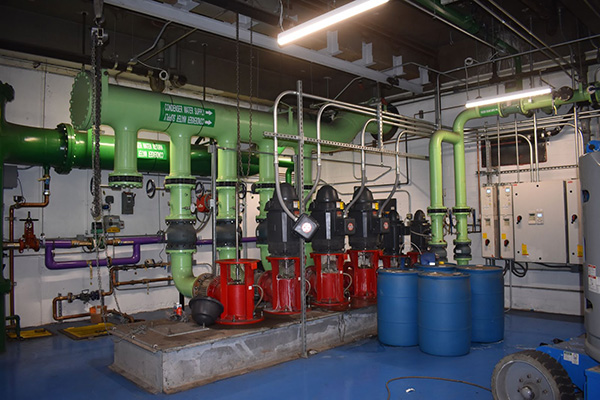Lessons learned from retrofitting Johnson Controls Norman, OK manufacturing facility, created a blueprint for global customers.
By Mark Reinbold, vice president of Global Sustainable Infrastructure, Johnson Controls
Being a true pioneer requires blazing the trail into uncharted territory and often “building the plane as you fly it.” Being the first at anything is inherently risky, but if you succeed, you lay down a path for others to follow. Johnson Controls knows that to help other organizations create smarter, healthier and more sustainable buildings, it first has to set the standard for what’s possible itself.
Johnson Controls shares many of the same challenges and end goals as the customers it serves every day. For example, it’s also participating in the race to net zero and is under pressure to upgrade its infrastructure while preserving resources. Being in a similar boat as its customers is a business advantage since every obstacle the company meets along its own net zero journey mirrors what customers are also facing. And solutions that drive results across its own facilities are likely to be valuable for others, too.
When Johnson Controls took on an industrial sustainability project of unprecedented scale at one of its top manufacturing plants, it used the opportunity to show, not tell, the impact of its products and services and inspire others.
Johnson Controls set a goal to achieve net zero Scope 1 and Scope 2 emissions by 2040. To accelerate progress toward this objective, its experts assessed its facilities worldwide to identify the best targets for decarbonization using its own cutting-edge technology and financing. They zeroed in on a powerhouse manufacturing plant in Norman, Oklahoma, that was among the company’s top CO2 emitters. This 900,000-square-foot plant is a flagship research, manufacturing and testing facility of Johnson Controls HVAC rooftop units.
Relying on decades of experience designing similar outcomes-based projects for its customers, the team came up with a game plan to modernize the infrastructure at the Norman plant. While the primary purpose was to enable the campus to perform more efficiently and lessen its environmental impact, these upgrades also served to extend the lifecycles and uptime of systems and improve production.
All these elements combined led to a more resilient facility. Having the latest building technologies is helping the plant ensure continuity of services, adapt to changing demands and bounce back faster from adverse events. This heightened resiliency will decrease short- and long-term costs and risks and increase factors like reliability and trust.

Like other organizations embarking on these types of initiatives, Johnson Controls needed to fund the planned improvements without draining its capital or adding debt. To do so, it took advantage of an Infrastructure-as-a-Service (IaaS) model to upgrade its assets while protecting its balance sheet. Through an IaaS agreement, Johnson Controls will pay for the Norman project via a fixed monthly fee to lower inherent risk and avoid hefty capital investments.
IaaS financing agreements allow organizations to offload the risk of sustainability and modernization projects to their service provider, making their provider responsible for aspects like lifecycle planning, funding and servicing. Since these models are tied to measurable outcomes, customers can also use the guaranteed savings to offset their regular payments, keeping costs low.
With the right financing mechanism in place, a team of facility leaders, engineers and C-suite leaders deployed a comprehensive, yet cost-effective, facility upgrade at the Norman plant. Central to this project was a more efficient central utility plant that’s managed, monitored and optimized by the company’s OpenBlue digital platform. The platform provides automated emissions reporting and actionable insights from data to support better energy and facility operations. The team also installed a solar panel carport to generate on-site renewable energy, along with electric vehicle charging stations. Additionally, they installed a new compressed air system and plug load controls, replaced high- and low-voltage transformers and implemented measures to save 3.5 million gallons of purchased water per year.
Although Johnson Controls was confident in its depth of experience, powerful technology and services, and innovative financing solutions, the scale of the Norman project was still a first – and therefore a risk. However, it’s one that will pay off in a major way. The plant’s greenhouse gas emissions are projected to be reduced by 43%, generating $960,000 in annual savings. The upgrades were also completed with minimal disruption to the operations of this bustling, business-critical site. Overall, the project drove home just how many positive outcomes are possible – from reduced carbon emissions to lower utility usage and bills to more productive processes – when advanced technologies are in place. Finally, it illustrated that these cutting-edge technologies can be accessible without taking a big chunk out of organizations’ capital.
Since the Norman plant faces challenges common at all manufacturing sites, this project’s outcomes are highly reproducible. The hope is that other industrial leaders charged with, or passionate about, meeting sustainability goals in their own facilities will look to Norman as a case study for how to get momentum. By “walking the talk” with this project, Johnson Controls can translate its own experiences into real and honest insights for customers, helping them aim high and take the decarbonization leap.

Mark Reinbold, Vice President of Global Sustainable Infrastructure at Johnson Controls, leads a global team of 900+ innovators who are responsible for the construction and implementation of over $1B in new projects each year that deliver efficiency, decarbonization, resiliency and drive the energy transition.
Scott Ellyson, CEO of East West Manufacturing, brings decades of global manufacturing and supply chain leadership to the conversation. In this episode, he shares practical insights on scaling operations, navigating complexity, and building resilient manufacturing networks in an increasingly connected world.